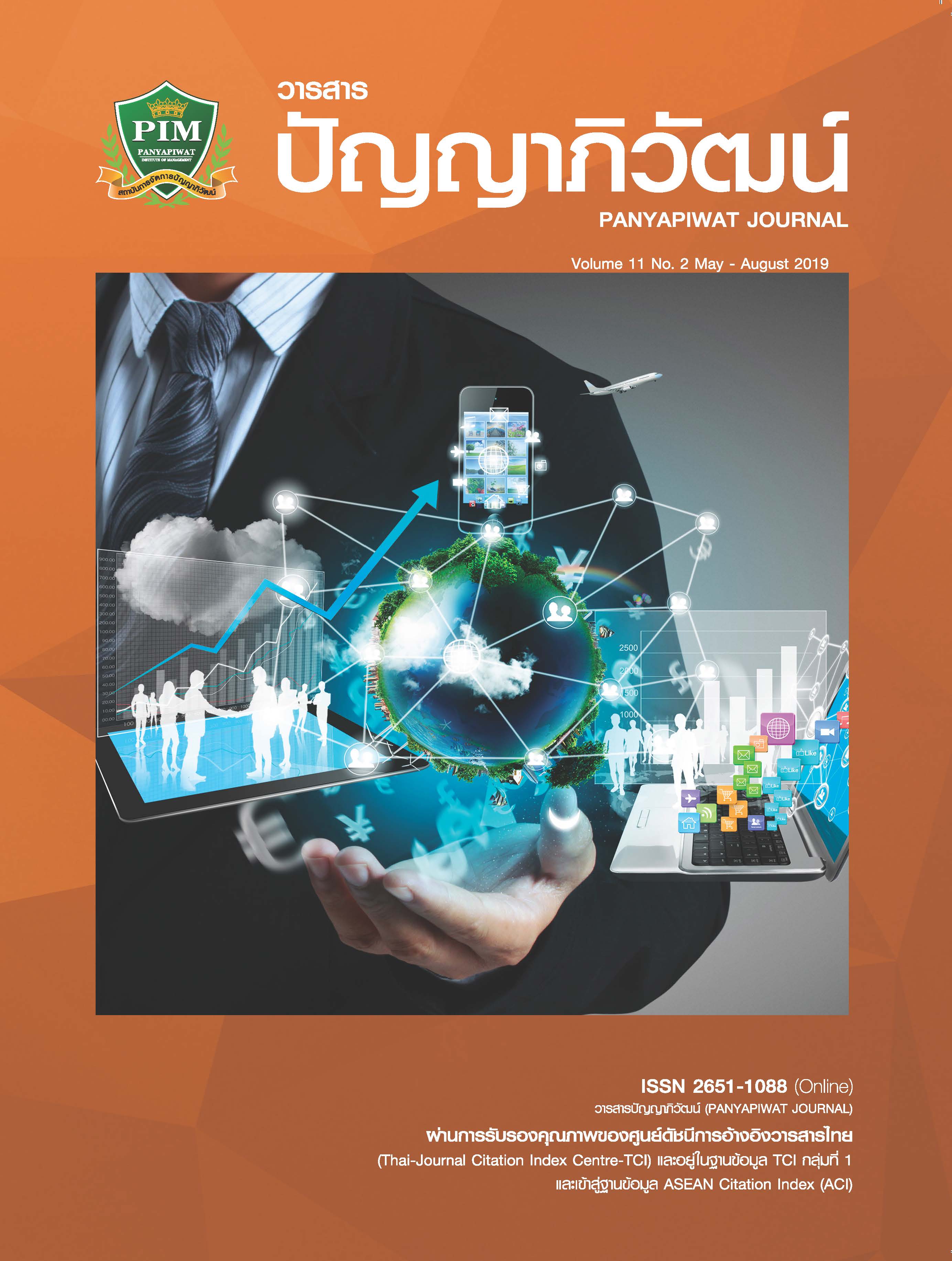STUDY ON THE IMPACT OF GOVERNMENT SCIENCE AND TECHNOLOGY INNOVATION SUBSIDIES ON ENTERPRISE TECHNOLOGICAL INNOVATIVE ABILITY BASED ON THE PERSPECTIVE OF INTERNAL CONTROL
Main Article Content
บทคัดย่อ
In the context where Chinese government has been constantly increasing science and technology innovation subsidies but only made few achievements, the factors affecting the effect of science and technology innovation subsidies from the government have become hot issues. Taking high-tech listed companies between 2013 and 2016 as samples and applying the data envelopment analysis (DEA) method, this paper launches studies on R&D input and output of enterprises, so as to measure their innovative ability. As indicated in the empirical results, government science and technology innovation subsidies have lifted enterprise innovative ability, and further studies have shown that internal control is positively regulating the impact of government science and technology innovation subsidies on enterprise innovative ability. The study not only proves the positive impact of government science and technology innovation subsidies on enterprise innovative ability, but also figures out one way for China to further improve the effect of government science and technology innovation subsidies, which is government science and technology innovation subsidies shall be granted to the enterprises with highly effective internal control.
Article Details
“ข้าพเจ้าและผู้เขียนร่วม (ถ้ามี) ขอรับรองว่า บทความที่เสนอมานี้ยังไม่เคยได้รับการตีพิมพ์และไม่ได้อยู่ระหว่างกระบวนการพิจารณาลงตีพิมพ์ในวารสารหรือแหล่งเผยแพร่อื่นใด ข้าพเจ้าและผู้เขียนร่วมยอมรับหลักเกณฑ์การพิจารณาต้นฉบับ ทั้งยินยอมให้กองบรรณาธิการมีสิทธิ์พิจารณาและตรวจแก้ต้นฉบับได้ตามที่เห็นสมควร พร้อมนี้ขอมอบลิขสิทธิ์บทความที่ได้รับการตีพิมพ์ให้แก่สถาบันการจัดการปัญญาภิวัฒน์หากมีการฟ้องร้องเรื่องการละเมิดลิขสิทธิ์เกี่ยวกับภาพ กราฟ ข้อความส่วนใดส่วนหนึ่งและ/หรือข้อคิดเห็นที่ปรากฏในบทความข้าพเจ้าและผู้เขียนร่วมยินยอมรับผิดชอบแต่เพียงฝ่ายเดียว”
เอกสารอ้างอิง
An, T. L., Zhou, S. & Pi, J. C. (2008). The Stimulating Effects of R&D Subsidies on Independent Innovation of Chinese Enterprises. Economic Research Journal, (10), 87-98. [in Chinese]
Bai, J. H. & Li, R. X. (2013). Review of Government R&D Funding on Enterprises’ Technological Innovation. Forum on Science and Technology in Chinese, 1(9), 32-37. [in Chinese]
Charnes, A., Cooper, W. W. & Rhodes, E. (1978). Measuring the effciency of making units. European journal of operational research, 2(6), 429-444.
Chen, H. & Zhao, X. (2008). Effect of Government Science and Technology Subsidies on Large and Medium Industry Enterprise R&D Output–an Analysis based on the Panel Data of Different
Provinces. Science of Science and Management of S&T, 26(3), 519- 525. [in Chinese]
Gao, H. W. (2011). Forum on Science and Technology in China. Forum on Science and Technology, (8), 15-20. [in Chinese]
Hamberg, G. (1966). R&D: Essay on the Economics of Research & Development. New York: Random House.
Huang, L. Q. (2016). Study on Internal Quality Control and Company R&D Investment Effciency: based on Empirical Evidence from Listed High-tech Companies. Journal of Fuzhou University (Philosophy and Social Sciences), (6), 50-57. [in Chinese]
Li, X. H. & Yang, Z. X. (2013). Study on Internal Quality Control and Creditor Protection: based on the Perspective of Debt Covenant Features. Journal of Audit & Economics, (2), 97-105. [in Chinese]
Li, Y., Ye, W. N. & Wang, Z. Y. (2013). Effects of Government’s R&D Subsidy on Firms: C
omplement or Crowding out Evidence from Shanghai in China. Science and Technology Management Research, 33(5), 62-66. [in Chinese]
Lv, H. Z. (2011). Research on Earnings Management and Internal Control Self-assessment of Government Subsidy of Listed Companies. Master’s Dissertation of the Tianjin University of Finance and Economics, TianJing China. [in Chinese]
Nola, H. D. (2009). Output Additionally of Public Support for Innovation: Evidence for Irish Manufacturing Plants. European Planning Studies, (10), 107-122.
Shi, X. X. & Lu, Z. H. (2010). The Relationship between R&D Effciency and Economic Performance: An Empirical Study based on Firm Level Data. Science of Science and Management of S&T, 31(7), 23-27. [in Chinese]
Su, J. & Luo, J. J. (2016). The influence of business model innovation on the performance of entrepreneurial enterprises: a study of the new three board listed companies in china. Panyapiwat Journal, 8(Suppl.), 74-88.
Weisberg, J. (1996). Differential teamwork performance the impact of general and specifc human capital levels. International Journal of Manpower, 17(8), 18-29.
Xiao, W. & Lin, G. B. (2014). Government Support, R&D Management and the Effciency of Technological Innovation: An Empirical Study on China Industry. Management World, (4), 71-80. [in Chinese]
Xu, Z., He, Y. & Wang, H. (2012). A Study of Factors that Affect Governments’ R&D Supports and Enterprises’ R&D Investment–Based on Research of System Dynamics. Management Review, 24(4), 67-75. [in Chinese]
Yang, D. M., Lin, B. & Wang, Y. C. (2009). Internal Control, Audit Quality and Large Shareholder Tunneling. Auditing Research, (5), 74-81. [in Chinese]
Zhao, X. & Zhang, X. S. (2013). Internal Control, Managerial Power and M&A Performance: Evidence from the Chinese Securities Market. Nankai Business Review, 16(2), 75-81. [in Chinese]
Zheng, Z. C. (2014). Research on Government Grants Allocation Effciency and Effectiveness of Internal Control in Listed Company. Master’s Dissertation of the Southwestern University of Finance and Economics, ChengDu China. [in Chinese]


